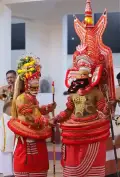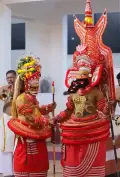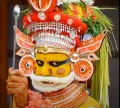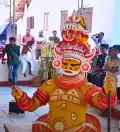In the conceptions of God in North Kerala, Muthappan God has the most important place. There is not a single land in Kannur district that does not perform great Muthappan theyyam. There are innumerable Muttappan Madappuras(Muthappan temple is known as Madappura) in North Kerala.
This is how the story of Muthappan begins. Iyenkara was a famous illam(Brahmin Family) of Eriveshi village in Kannur district. Vazhunnor of Iyenkara Illam and wife Patikutty Antarjan had no children. A devotee of Shiva, Patikutty Antharjanam performed constant prayers and poojas for Child. One day, after singing, Antharjana had a vision of Shiva in his dream. The next day, when she came to bathe in the stream, she saw a baby lying on the bank of the stream. Realizing that it was a blessing from Lord Shiva, Patikutiamma brought the baby to Illum. Iyenkara gave the boy all the blessings and brought him up as his own son. But after each stage of growth he did not observe any of the Brahminical rites of Illam. He befriended the lower castes near Illam, took bow and arrow in the forest and went hunting and ate meat, these activities was against Bhrahmins custom. The Iyenkara Illatuls were disappointed by this and asked the child to follow the Illat custom. But he was not ready for that. Iyenkara Vazhunnore and Patikutty were deeply saddened. Realizing this, the child showed his universal form to his parents one day, and when he saw the divine form with a bow and arrow and flaming fire eyes, the parents realized that this was not an ordinary child but God. They prostrated before him and the child blessed them. The son told his parents the purpose of his incarnation and departed from there. As ordinary people could not bear the brilliance of the Lord’s eyes, Patikutiamma presented Lord with a metal eyeball while leaving.
Lord traveled to Malanadu and reached a place called Kunnathur Padi. Lord settled in the scenic Kunnathur padi where Palm toddy is easily accessible and has a lot of palm trees. Then he regularly took toddy from the toddy pot in the palm tree and drank it. Chandan, a young man who noticed that toddy was constantly being stolen from his palm tree, guarded his palm trees until Chandan saw the old man drinking toddy from his palm tree. Angered by this, Chandan took the bow and arrow in his hand and prepared to shoot at the old man, realizing this, Lord turned Chandan into a stone by his divine power.
Chandan’s wife, who had not seen her husband for a long time, went looking for him and found Chandan standing next to a palm tree. When she looked around with great distress, she saw an old man on top of the tree. She cried and called him ‘my muthappa’ which means ‘grandfather’. Bhagavan heard her call and blessed her and gave re birth to Chandan. Thus Bhagavan came to be known as Muthappan. Chandan and his wife offered toddy, boiled corn, dried fish and coconut piece as offerings to Muthappan.
After staying at Kunnathur Pati for several years, Muttappan decided to move to another suitable place for the fulfillment of his incarnational goal. From Kunnathur Padi, Muttappan threw a arrow to the sky by his bow and the arrow landed at the place called Parasshini Kadav. A person from the Vannan community saw the bright arrow stuck in a wormwood tree and felt that there was something unusual about the arrow. This land belongs to Kunnummal family, and Vannan informed this to Kunnummal family ancester. The story goes that the ancester who came to see the arrow with fear and devotion received the darshan of Muttappan, and the ancester built a Madappura for Muttappan. It is believed that the ancester left by the Muthappan is still there in the altar of Parshinikadav.
It is said that Muthappan had three hundred and eight Madapuras in the past, but today Mutthappan has countless Madapuras. There are various ways of worshiping Muthappan like Painkuti, Eka Pooja, Vellatam, Thiruvopana, Marayut and Madhukalasam. Painkuti is the worship of offering items of one’s choice to one’s Muthappan, just as in the West one gives one’s choice of food to one’s ancestors. Chandan and his wife offer the prasadam to Muthappan at Kunnathur Pati. Making an offering to one’s Muthappan is called Muthirkukka. Muthirkukka can have Cooked with boiled grains (peas, peas), dried fish, green fish, tofu, rak, betel nut, adakka, meat etc. People from Adiyaan, Thiya and Vannan communities are the ones who make Painkuti. Pujas and rituals related to Muttappan are performed by the members of the Thiya community. Those who do karmas are called Madayars and those who do upa karmas are called Kalaskaras.
Two grandfathers, Vellattam and Thiruvappan, are usually seen in Muttappan Matappuras. It is believed that Thiruvappan is Lord Vishnu and Vellatam is Lord Shiva. Thiruvappan Theyyam’s hair will have fish art and Vellatam Theyyam’s hair will have a crescent moon. Usually Tiruvappan is tied by the Anjutan community and Vellatam by the Vannan community, but in Parasshinikadu both are tied by the Vannan community. Thus, two Theyyam representing the Shaiva Vaishnava concepts in one God are performed by Muttappa at Parassini and other temples. However, only Vellatam, a Shiva concept, is usually performed at the time of Muthappan’s performing in the family homes.
Although Muttappan’s origin place is Kunnathur Padi, there is no permanent Muttappan Madapura there. During the festival, it is customary to make a temporary mudapura with straw. Muthappan usually has very simple matapuras. Mutthappan’s huts are also in line with the life concepts of Mutthappan, who gave up all his fortunes and came to live with common people. Although there are innumerable Madappuras, Parassini Madappura is a place where many people come from different parts of Kerala and outside Kerala. Parasshinikadav is Muttappan Kav where anyone can visit regardless of caste, religion or any other conditions.
If called, it is said that Muthappan is God on call. From the famous saying of Muttappa, “You will not stop those who have come, you will not call those who have gone.” That is why Muthapapan is described as the most popular god in North Kerala.










